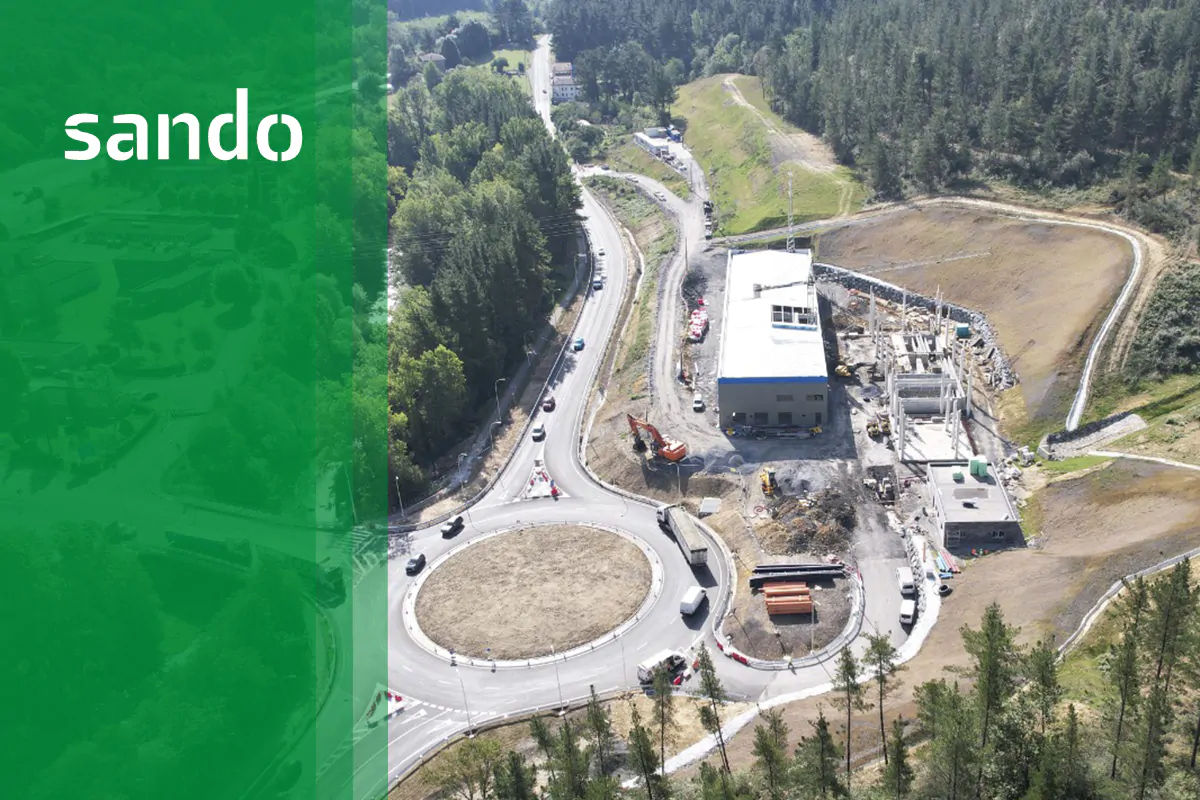
07/02/2024
Sando Construcción, in a joint venture and with the collaboration of Sando Agua, is building the Basaurbe Wastewater Treatment Plant (WWTP) in Llodio for the Cantabrian Hydrographic Confederation (CHC) as part of the “Sanitation Master Plan for the Upper Nervión River Basin”.
A project within the Integral water cycle will provide a water treatment service to about 24,000 inhabitants of Llodio town in the Nervión basin, crossed by the Altube River, in the Basque Country. The new WWTP will have an average flow rate of 360 m3/h, a peak flow rate of 648 m3/h and a maximum flow rate of 1764 m3/h.
The execution of this work allows water to be piped to the WWTP in two ways: using two cast iron pipes from the Llodio storm tank to the roughing building and through the neighbourhood of La Cadena and Orozko (Vizcaya), and using three polythene impulsion pipes of different diameters that also reach the roughing building. Around 80,000 m3 of material from the excavations was mobilised for its execution, which was used for the actual backfilling of the work, the roundabout, access Roads and the restoration of the existing old quarry road.
One of the most critical actions consists of channelling the Ortube stream using a 1,500-millimetre collector with a length of over 110 metres and three-metre-high manholes, which crosses the entire project, and the A-2522 Llodio-Orozko road underground to the Altube river. For the beginning of the channelling, a breakwater tongue has been built, which is integrated into the mountain landscape so that the discharge is carried directly into one of the chambers and from there to the 1,500-millimetre pipe.
The infrastructure design envisages prefabricated buildings covering the sewage treatment plant entirely. This feature allows for a deodorisation system made entirely of polypropylene (PP). In this sense, the biological building (biological tanks, membrane area and blowers) has a surface area of 1,632.8 m2, with an approximate volume of 15,185.04 m3. The pre-treatment building (roughing areas, desander-degreaser, safety screens, lamellar decanter) has a surface area of 716.86 m2 and an approximate volume of 7,100 m3. Finally, the sludge building has tanks of approximately 1010 m3 at a depth of 6.45 metres. The surface area of the sludge building is 200 m2 with a volume of 1980 m3.
The access roundabout to the WWTP, with a length of 56 metres in diameter and two 4.40-metre-wide lanes, is also being built next to it. In addition, to integrate the work into the landscape, the Sando-Aquambiente joint venture has carried out hydro-seeding in the roundabout in accordance with that carried out on the slopes of the WWTP, as well as planting native trees and shrubs as part of the project’s landscape integration plan.
The UTE has obtained the certification of an Energy Management System according to ISO 50001:201, which allows it to implement an energy policy and adequately manage the energy aspects derived from its activity. To contribute to energy efficiency, photovoltaic panels will be installed in the control building to heat the water, and the windows will be double-glazed to reduce energy consumption for heating and air-conditioning. Also, in line with the project’s policy of zero emissions and contribution to the circular economy, 14 streetlights will be installed with LED light fixtures, and five others will be replaced.
Under Sando Construcción’s commitment to Sustainability and the circular economy, the materials used in the project include the excavated fill from the site, as well as some 500,000 kilos of steel and 10,000 m3 of HA30, HA25, HM20 concrete, and buried pipelines with a total length of approximately 1,000 metres
This project’s innovative aspects include installing hollow fibre membranes as a purification solution for the WWTP. A system currently being implemented in almost all newly constructed water treatment buildings or extensions to existing wastewater treatment plants. This system is a valuable piece of equipment that requires a high degree of specialisation in handling, as it must be kept in a dry place at a temperature of between 5º and 35º before installation and commissioning.
In addition, to ensure the maximum operability of the Basaurbe WWTP, SCADA plant automation technology is integrated, which controls the entire process from the instrumentation, pumps, emptying and filling flows to the floodgates. An intelligent oxygen control system will be installed in the biological reactor, and effluent discharge parameters will be monitored. It is a system that will optimise the management of this scarce water resource and the purification process to minimise possible negative impacts on the environment.